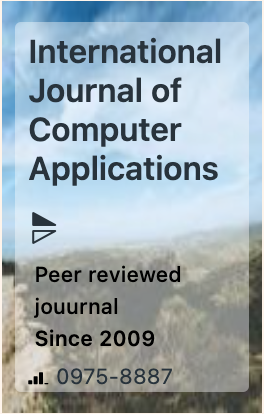The week's pick
Random Articles
Reseach Article
Image Tamper Detection using the Fusion CMFD Model with Advanced VGG16 Features
| International Journal of Computer Applications |
| Foundation of Computer Science (FCS), NY, USA |
| Volume 186 - Number 62 |
| Year of Publication: 2025 |
| Authors: Smruti Dilip Dabhole, G.G. Rajput, Rajendra Hegadi, Prashantha |
 10.5120/ijca2025924399
10.5120/ijca2025924399
|
Smruti Dilip Dabhole, G.G. Rajput, Rajendra Hegadi, Prashantha . Image Tamper Detection using the Fusion CMFD Model with Advanced VGG16 Features. International Journal of Computer Applications. 186, 62 ( Jan 2025), 42-51. DOI=10.5120/ijca2025924399
Abstract
Due to the widespread availability of the internet and the abundance of devices capable of capturing images, there has been a significant increase in the number of images shared online. These images are easily manipulated using advanced software tools like Adobe Photoshop, leading to the creation of fake visuals. As the sophistication of image and video editing tools continues to advance, distinguishing between authentic and altered images has become increasingly challenging. Thus, it is crucial to verify the authenticity of images before deriving any significant insights from them. In this paper we present a novel method for detecting and categorizing tampered and genuine regions within images, without reliance on reference images. The proposed novel approach called ‘Fusion CMFD’ ‘Copy Move Forgery Detection (CMFD)’, model includes fusion of ‘Manipulation CMFD’ model and ‘Similarity CMFD’ model. Features are extracted in both models using VGG16 neural network architecture where, features from convolutional layers are intelligently concatenated to enhance discriminative power and facilitate more accurate identification of genuine and tampered regions within an image. ‘Similarity CMFD’ model employs the VGG16 architecture, utilizing self-correlation to assess feature similarity between the input image and its corresponding mask. Potential features are aggregated using Percentile Pooling, and then a Mask Decoder is utilized to upscale feature maps to the original image dimensions. ‘Manipulation CMFD’ includes feature extraction using VGG16 and mask decoder. The proposed innovative approach promises enhanced accuracy and robustness in detecting tampered and genuine regions within images, opening up new avenues in the field of image forensics and enhancing overall security measures in digital content authentication. Experiments are performed on images from the MICC-F2000 [1] dataset. The results are compared against existing methodologies reported in the literature and cross verified with MICC-F220 dataset. Performance has been analyzed using parameters namely, accuracy, precision and recall.
References
- Zanardelli, Marcello, et al. "Image forgery detection: a survey of recent deep-learning approaches." Multimedia Tools and Applications 82.12 (2023): 17521-17566.
- Rodriguez-Ortega, Y.; Ballesteros, D.M.; Renza, D. Copy-Move Forgery Detection (CMFD) Using Deep Learning for Image and Video Forensics. J. Imaging 2021, 7, 59. https://doi.org/10.3390/ jimaging7030059
- D. Prabakar, R. Ganesan, D. L. Rani, P. Neti, N. Kalyani and S. K. Mudradi, "Hybrid Deep Learning Model for Copy Move Image Forgery Detection," 2022 Sixth International Conference on I-SMAC (IoT in Social, Mobile, Analytics and Cloud) (I-SMAC), Dharan, Nepal, 2022, pp. 1023-1028, doi: 10.1109/I-SMAC55078.2022.9987319.
- Ibrahim A. Zedan, Mona M. Soliman, Khaled M. Elsayed, Hoda M. Onsi, “A New Matching Strategy for SIFT Based Copy-Move Forgery Detection”, International Journal of Intelligent Engineering and Systems · June 2023 DOI: 10.22266/ijies2023.0831.34
- Wenyu Chen, Yanli Zhao, Wenzhi Xie and Nan Sang, "An improved SIFT algorithm for image feature-matching," 2011 International Conference on Multimedia Technology, Hangzhou, 2011, pp. 197-200, doi: 10.1109/ICMT.2011.6003022.
- G. G. Rajput and S. B. Ummapure, "Script identification from handwritten documents using SIFT method," 2017 IEEE International Conference on Power, Control, Signals and Instrumentation Engineering (ICPCSI), Chennai, India, 2017, pp. 520-526, doi: 10.1109/ICPCSI.2017.8392348
- Irene Amerini, Lamberto Ballan, Roberto Caldelli, Alberto Del Bimbo, Luca Del Tongo, Giuseppe Serra, Copy-move forgery detection and localization by means of robust clustering with J-Linkage, Signal Processing: Image Communication 28(2013) 659–669
- Deb, P., Kar, N., Hassan, K.L. et al. Advanced copy-move forgery detection: utilizing AKAZE in conjunction with SIFT algorithm for image forensics. Microsyst Technol (2024). https://doi.org/10.1007/s00542-024-05773-1
- K. M. Hosny, A. M. Mortda, M. M. Fouda and N. A. Lashin, "An Efficient CNN Model to Detect Copy-Move Image Forgery," in IEEE Access, vol. 10, pp. 48622-48632, 2022, doi: 10.1109/ACCESS.2022.3172273.
- Azra Parveen, Zishan Husain Khan, Syed Naseem Ahmad, “Block‑based copy–move image forgery detection using DCT”, Iran Journal of Computer Science https://doi.org/10.1007/s42044-019-00029-y, Received: 22 June 2018 / Accepted: 8 January 2019 © Springer Nature Switzerland AG 2019
- Chengyou Wang , Zhi Zhang and Xiao Zhou, “An Image Copy-Move Forgery Detection Scheme Based on A-KAZE and SURF Features”, Symmetry 2018, 10, 706; doi:10.3390/sym10120706
- Rajkumar, R., 2023. Deep Learning Feature Extraction Using Attention-Based DenseNet 121 for Copy Move Forgery Detection. International Journal of Image and Graphics, 23(05), p.2350042.
- Esha Tripathi, Upendra Kumar, Surya Prakash Tripathi, “Comparative Analysis of Techniques Used to Detect CopyMove Tampering for Real-World Electronic Images”, INTERNATIONAL JOURNAL OF INTEGRATED ENGINEERING VOL. 15 NO. 4 (2023) 201-225
- Nidhi Goel, Samarjeet Kaur, Ruchika Bala, Dual branch convolutional neural network for copy move forgery detection, IET Image Processing
- Nagaveni K. Hebbar and Ashwini S. Kunte, “Transfer Learning Approach For Splicing And Copy-Move Image Tampering Detection”, Ictact Journal On Image And Video Processing, MAY 2021, VOLUME: 11, ISSUE: 04ISSN: 0976-9102 (ONLINE) DOI: 10.21917/Ijivp.2021.0348
- Asghar, Khurshid & Sun, Xianfang & Rosin, Paul & Khatana, Mubbashar & Hussain, Muhammad & Habib, Zulfiqar. (2019). Edge–texture feature-based image forgery detection with cross-dataset evaluation. Machine Vision and Applications. 30. 10.1007/s00138-019-01048-2.
- Noh, H., Hong, S., Han, B.: Learning deconvolution network for semantic segmentation. In:Proceedings of the IEEE International Conference on Computer Vision. pp. 1520–1528 (2015)
- Wojna, Z., Ferrari, V., Guadarrama, S., Silberman, N., Chen, L.C., Fathi, A., Uijlings, J.: The devil is in the decoder (2017)
- Long, J., Shelhamer, E., Darrell, T.: Fully convolutional networks for semantic segmentation. In: Proceedings of the IEEE Conference on Computer Vision and Pattern Recognition. pp. 3431–3440 (2015)
- Elaskily, M.A., Elnemr, H.A., Dessouky, M.M. et al. Two stages object recognition based copy-move forgery detection algorithm. Multimed Tools Appl 78, 15353–15373 (2019). https://doi.org/10.1007/s11042-018-6891-7
- Osamah M. Al-Qershi,Bee Ee Khoo, “Enhanced block-based copy-move forgery detection using k-means clustering”, Multidimensional Systems and Signal Processing, © Springer Science+Business Media, LLC, part of Springer Nature 2018
- Simonyan, K., Zisserman, A.: Very deep convolutional networks for large-scale image recognition. CoRR abs/1409.1556 (2014)
- Kaur, N., Jindal, N. & Singh, K. A deep learning framework for copy-move forgery detection in digital images. Multimed Tools Appl 82, 17741–17768 (2023). https://doi.org/10.1007/s11042-022-14016-2
- Irene Amerini; Lamberto Ballan; Roberto Caldelli; Alberto Del Bimbo; Giuseppe Serra ,“A SIFT-Based Forensic Method for Copy–Move Attack Detection and Transformation Recovery”, IEEE Transactions on Information Forensics and Security ( Volume: 6, Issue: 3, September 2011)
- Ye, W., Zeng, Q., Peng, Y. et al. A two-stage detection method of copy-move forgery based on parallel feature fusion. J Wireless Com Network 2022, 30 (2022). https://doi.org/10.1186/s13638-022-02112-8
- Tralic D., Zupancic I., Grgic S., Grgic M., "CoMoFoD - New Database for Copy-Move Forgery Detection", in Proc. 55th International Symposium ELMAR-2013, pp. 49-54, September 2013
- Selvaraj, Arivazhagan & Shebiah, Newlin & M, Saranyaa & R, Shanmuga. (2024). CNN-based Approach for Robust Detection of Copy-Move Forgery in Images. Inteligencia Artificial. 27. 80-91. 10.4114/intartif.vol27iss73pp80-91.
- Ahmed Sedik, Yassine Maleh, Ghada M. El Banby, Ashraf A.M. Khalaf, Fathi E. Abd El-Samie, Brij B Gupta, Konstantinos Psannis, Ahmed A. Abd El-Latif, AI-enabled digital forgery analysis and crucial interactions monitoring in smart communities, Technological Forecasting and Social Change, Volume 177, 2022, 121555, ISSN 0040-1625,
- Vaishali, Sharma & Neetu, Singh. (2023). Enhanced copy-move forgery detection using deep convolutional neural network (DCNN) employing the ResNet-101 transfer learning model. Multimedia Tools and Applications. 1-25. 10.1007/s11042-023-15724-z.
- Muniappan, T. ., Abd Warif, N. B. ., Ismail, A. . and Mat Abir, N. A. . (2023) “An Evaluation of Convolutional Neural Network (CNN) Model for Copy-Move and Splicing Forgery Detection”, International Journal of Intelligent Systems and Applications in Engineering, 11(2), pp. 730–740.
- Elaskily, M.A., Alkinani, M.H., Sedik, A. and Dessouky, M.M., 2021. Deep learning based algorithm (ConvLSTM) for copy move forgery detection. Journal of Intelligent & Fuzzy Systems, 40(3), pp.4385-4405.
Index Terms
Keywords

